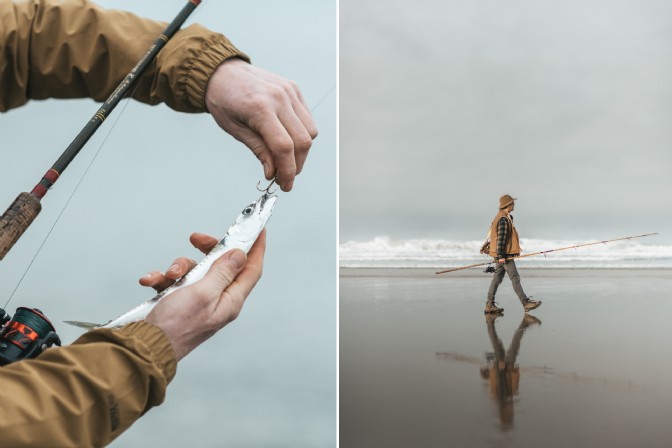We’ve had many moons of field to fork. Now is the time of coast to countertop. While winter foraging might not suit folk of the fair-weather variety — with rock pools and clag and sand in all manner of places — this is one season worth wearing wellies for. Look past the deceptive bleakness of those mudflats and estuaries, and you’ll find one of the most reliable habitats for foragers: winkles and whiting, sea beet and samphire, rock oysters and rosehip in their tangier-and-tangy hundreds.
We spent a day foraging on the Cornish coast with Simon Greenwood — private chef of River Cottage and Hotel Endsleigh, who has produced plates for everyone from surfers to Steven Spielberg — and carted our catch to Talisman in nets and buckets, where Simon served scallops with seaweed ketchup, eaten by candlelight..
"Growing up in Dorset by the sea, and now working extensively around the Devon and Cornwall coast, I've become fascinated with utilising what grows so abundantly by the sea. Being a keen walker and angler, I take every opportunity to blow away the cobwebs and forage for wonderful ingredients while walking my dog, even in the colder winter months."
"Seaweed is always in abundance, and generally harvested during low tide; kelp, sea spaghetti, dulce, and green gut weed are some favourites. Sea plants can also be found on marshes, whilst rocky backdrops are a fantastic place to source marsh samphire and sea purslane. Shellfish can be found also in abundance; I often find clams buried in sandy substrates, and mussels or winkles along shorelines and intertidal zones." To celebrate the season for coastal winter foraging, Simon shares a recipe for utilising marsh samphire and seaweed.
Scallops with foraged marsh samphire and seaweed ketchup
A recipe by Simon Greenwood
Ingredients:
- 500g marsh samphire
- 10 scallops (shell on)
- Knob of butter
For the ketchup:
- 200g spaghetti seaweed
- 200gm Dulce Seaweed
- 60ml Cornish cider vinegar
- 20gm caster sugar
- 20gm tomato puree
- 2 bay leaves
- 2 whole cloves
- 2 cardamom pods
- Zest of half a lemon
- 1 tsp of sweet paprika
- 1 tsp mustard powder
- ½ tsp celery salt
- ½ tsp ground ginger
- ¼ tsp mace
- ¼ tsp all spice
- ¼ tsp cinnamon
- ¼ teaspoon pepper
- Pinch of salt
Method
In separate bowls, soak the foraged seaweed and marsh samphire in water with some sea salt for 1-2 hours. Then rinse well, drain, and set to the side.
Preheat the oven to 130 degrees Celsius. Spread the drained seaweed on a baking tray lined with parchment paper and bake until crispy, without browning.
In a saucepan, combine the crispy seaweed with boiling water (enough to cover it), tomato puree, spices, and other ketchup ingredients (not the marsh samphire and scallops). Let it cool, then blend until smooth. Strain through a fine sieve for a smooth ketchup.
Seaweed is a natural thickening agent. If the ketchup is too thick, add a little water to adjust the consistency.
Blanch the soaked and drained samphire in boiling water with a pinch of bicarbonate of soda for 30 seconds, then shock in ice water. Drain and season with pepper and olive oil.
Remove scallops from the shell (or have your fishmonger do it) and season on both sides with Cornish sea salt.
Heat olive oil in a pan until smoking hot, sear the scallops for 2 minutes on one side, flip, and sear for 1 minute more. Add a generous knob of butter and lemon, then remove from the pan.
Place marsh samphire in the centre of scallop shells, top with seared scallops, and finish with a spoonful of seaweed ketchup.
Browse the collection of luxury homes in the UK and Ireland, where you can hire a private chef. Should you choose a property in Devon or Cornwall, you can reserve Simon Greenwood's culinary expertise.













